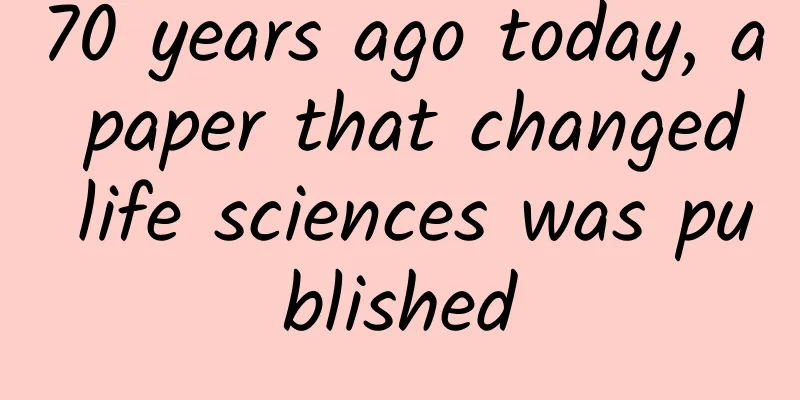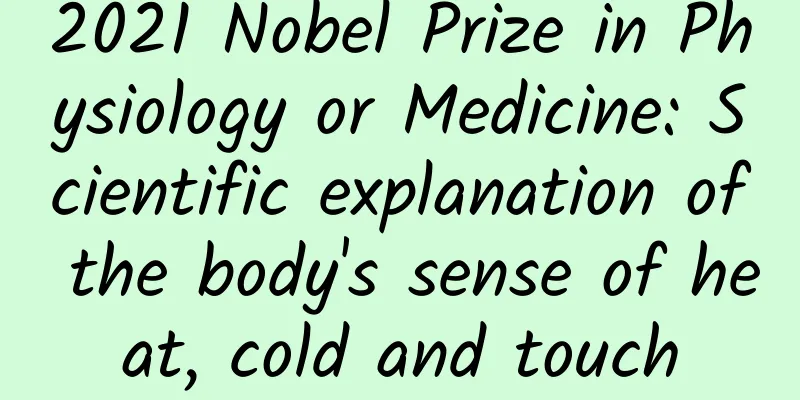70 years ago today, a paper that changed life sciences was published

|
On April 25, 1953, a paper that influenced the world was published in Nature - "Molecular Structure of Nucleic Acids". Since then, humans have understood the double helix structure of DNA and its significance to genetics. Today, let's recall this legend. Written by Qu Lijian On December 10, 1962, in Stockholm, Sweden, three scientists, Maurice Hugh Wilkins, Francis Crick and James Watson, took turns to receive the Nobel Prize in Physiology or Medicine, the highest honor in the scientific community. They were awarded for "the discovery of the molecular structure of nucleic acids and their importance in the transmission of information in living things." Their work was mainly completed in 1953, which is exactly 70 years ago. Among the three, Watson studied biology, while Wilkins and Crick both had a physics background. They entered the field of molecular biology and were inspired by the same book, Schrödinger's What Is Life? Let’s take a look at their stories… Met through a book As World War II was drawing to a close, scientists involved in the Manhattan Project were thinking about their post-war future. Some wanted to continue researching bigger bombs - hydrogen bombs, some wanted to study nuclear power generation, some wanted to continue their pre-war research, some wanted to find another direction for academic research, and some wanted to change careers and no longer be scientists. Maurice Wilkins was a British man who was involved in the research of isotope separation in the Manhattan Project. He was only 29 years old at the time and was also thinking about his future. He hoped to continue to engage in scientific research, but he would never do research related to nuclear physics again because the destructiveness of nuclear weapons made him uneasy. But what to do? One of Wilkins' colleagues, Harrie Massey, lent him a book, What is Life?, which was compiled based on a lecture given by quantum physicist Erwin Schrödinger at Trinity College Dublin, Northern Ireland, in February 1943. In the book, Schrödinger said that it was wrong to think that biology was independent of physics and chemistry, that biology should be studied at the molecular and atomic levels, and that both the biological and non-biological worlds follow the same laws of physics. Schrödinger specifically discussed his insights into genetic phenomena, that a gene should be a protein macromolecule (the mainstream view in the scientific community at the time was that genetic material was protein), and that the material structure of a gene was a non-periodic crystal structure. Wilkins was deeply attracted by the ideas in Schrödinger's book and knew what he wanted to do: he wanted to become a "biophysicist." He followed his doctoral supervisor, Professor John Randall, back to the UK to study biophysics, and the two eventually established a research group at King's College London. Massey also introduced him to a colleague, Francis Crick, who happened to be the same age as him. Crick received a bachelor of science degree from University College London in 1937. He was going to pursue a doctorate, but his laboratory facilities were destroyed by the bombing of the Nazi German army and his studies were interrupted. He then went to work in the British Admiralty, where his supervisor was the theoretical physicist Marcy, Wilkins' colleague in the Manhattan Project. After the war, Crick was confused about what he would do in the future. He did some applied research, but his achievements were not outstanding and he was not interested in it. He was interested in basic research, but he doubted his ability. Crick's friends said that he was very good at speaking and understood science, so he was very suitable for scientific communication. Crick thought this was a good idea. One day, he was talking about the latest scientific developments in his office. At night, he suddenly felt empty. His knowledge of these topics came only from some popular science publications, and he didn't have a deep understanding. He was not spreading science, but just chatting about science. Crick decided to do real science. What direction should he choose? He chose the direction that he was really interested in. Crick believed: Living for science, like living for religion, requires a high degree of dedication, and one can only be so devoted if he is passionate about the profession he is engaged in. How to find out what you are really interested in? Crick's method is called the small talk test, that is, what you are really interested in is what you chat about all day. Using this method, he found his own interests: Molecular biology: the intersection of life and non-life How the Brain Works – Neurobiology Based on his physics background, the first option seemed more plausible, so Crick decided not to hesitate and chose this one. Another factor that influenced Crick's choice was Schrödinger's book What is Life?, which was also lent to him by Marcy (I don't know if it was the same book). The message Crick got from the book was that life science was about to undergo a major change. At this time, Crick received a job offer from Hamilton Hartridge, an ophthalmic physiologist, and he would get a formal position. Crick struggled for a week and rejected the job, but decided to pursue his ideal and seek a job related to molecular biology. So he turned to his former boss, Marcy, now a professor at University College London, for help. Marcy introduced two people, one of whom was Wilkins, Marcy's colleague in the Manhattan Project. Crick visited Wilkins and learned that Wilkins was trying to apply physics techniques to observe cells, but Crick felt that this was too biological. Randall also didn't like Crick's boastful talk, so Crick and Wilkins had no chance to work together. But the two became good friends since then. After Crick separated from Wilkins, he moved around in several research groups and finally settled in the Cavendish Laboratory in Cambridge as a doctoral student. His research topic was to use X-ray crystal diffraction technology to study the structure of proteins. Crick finally got his wish and could study molecular biology. Wilkins and his new colleague Franklin Wilkins learned a major piece of news from a student in the group that American scientists had concluded from experiments that genetic material is DNA! If this is true, the structure and function of DNA will be the most important research topic in biology. Wilkins discussed with his boss Randall and stopped the work they had been doing, that is, developing a suitable microscope to study cells, and focused on DNA research. This decision was not easy to make, after all, they had invested a lot of time and energy in microscopes. It was the book What is Life? that made Wilkins make up his mind, because DNA should be the non-periodic crystal mentioned by Schrödinger. What tools are used to study DNA? A visiting scholar from the United States suggested the use of X-ray diffraction technology and mentioned that American biochemists used this technology to study the structure of viruses. Wilkins followed the advice. The next question was, where to get the samples? Wilkins and the X-ray diffraction instrument. Source: Wikipedia In May 1950, at an academic conference held in London, Rudolf Signer, a professor of organic chemistry at the University of Bern in Switzerland, generously took out several bottles of DNA molecule samples he prepared and let those in need take them. Signer proudly declared: I would claim that the quality of my samples is second to none, and I don’t know who would claim to be first. Wilkins obtained precious DNA samples in this way, and finally cracked the molecular structure of DNA with the help of Professor Signer's samples. Professor Signer's contribution is worth remembering, and his bright and generous scientific spirit is worth learning. However, Wilkins was not proficient in X-ray crystallography and was previously limited by samples, so his experiments progressed slowly. Therefore, he and his boss Randall decided to hire an X-ray crystallography expert. The position was held by physical chemist Rosalind Franklin. Franklin received a bachelor's degree from Cambridge University in 1940. During World War II, he served in the military while conducting research on coal. He received a doctorate from Cambridge University in 1945 based on his research results in this field. In 1947, he went to Paris for postdoctoral research and became an expert in X-ray crystallography. In 1951, he joined Randall's research group. When Franklin reported for duty, Wilkins was on vacation. Randall told Franklin that she and Wilkins' doctoral student Raymond Gosling would be responsible for the X-ray diffraction research of DNA. Franklin thought that he would be responsible for this research direction independently. When Wilkins returned from vacation, he found that his doctoral student was working with a new employee and mistakenly thought that his boss had assigned him an assistant. Due to personality differences, the two were unable to resolve the misunderstanding, and Randall, as their boss, did not make their relationship clear. The two colleagues had a bad relationship for the rest of their lives, which is a great regret in the history of science. Wilkins meets Watson From May 22 to 25, 1951, the UNESCO-sponsored academic conference "Symposium on The Submicroscopic Structure of the Protoplasm" was held in Naples, Italy. Wilkins decided to speak at the conference about the X-ray diffraction research on DNA that he and his student Gosling had done. Wilkins' report attracted great interest from a young American named James Watson. Watson loved bird watching since he was a child, but after reading Schrödinger's book What is Life? in 1946 while studying for his undergraduate degree at the University of Chicago, his ambition shifted from studying birds to genetics. Watson began studying for a doctorate at Indiana University in 1947. His main research direction was bacteriophages, and he used this to understand how genes control cell inheritance. Watson's mentors were biologist Salvador Luria and biophysicist Max Delbrück. Delbrück was a physicist who turned to biological research earlier, and he influenced Schrödinger to focus on biological issues. Watson's mentor Luria believed that in order to understand heredity, we must first understand the chemical structure of genes. Since he did not want to study chemistry anymore, the wise thing to do was to send one of his students to study chemistry under a chemist. He chose Watson. Luria carefully selected a mentor for Watson who was knowledgeable in both chemistry and genetics, Herman Kalckar from the University of Copenhagen in Denmark. Unfortunately, Luria's efforts were in vain. Kalckar was unable to inspire Watson's interest in chemistry, and he turned to another professor to continue his research on bacteriophages. However, Watson was still obsessed with the molecular structure of genes. In the conference hall in Naples, Wilkins began his report. Watson sat in the last row, listening to the report and reading the newspaper. Wilkins gradually talked about his and his students' research on DNA, and projected the clearest X-ray diffraction pattern of DNA crystals up to that time through slides. Watson was startled, raised his head, and the newspaper slipped under the table. Wilkins said that the X-ray diffraction pattern could infer the structure of DNA, so understanding the genetic principle of genes would not be far away. Wilkins's report was dull, but it made Watson fascinated by the study of DNA. During the meeting, Watson approached Wilkins and expressed his willingness to follow him in studying DNA using X-ray diffraction. He even used his sister who was traveling in Naples to seduce Wilkins, but failed to achieve his goal. The X-ray diffraction pattern of DNA presented by Wilkins at the Naples Conference. Image source: Watson's "Double Helix" After returning to Copenhagen, Watson read several papers by American chemist Linus Pauling on peptide X-ray diffraction and learned about the helical structure model of proteins proposed by Pauling. Watson thought that X-ray diffraction technology must have a future in nucleic acid research, which strengthened his determination to do DNA research. From whom can I learn the technique of analyzing X-ray diffraction patterns? Pauling? He was too famous, and I was too inexperienced and undertrained. He probably looked down on me. Wilkins? I don't want to put my warm face on Wilkins's cold butt again. Watson learned that Professor Max Perutz of the Cavendish Laboratory at Cambridge University used X-ray diffraction to study protein structure. Through the connections of his mentor Luria, he was able to work as a postdoctoral fellow under Perutz. Watson met Crick, who was studying for a doctorate under Perutz. Although Crick was 12 years older than Watson, the two hit it off right away and shared the same aspirations. In a protein research group, both believed that DNA was more important than protein. They had heated discussions every day, and Perutz assigned them to the same office so as not to disturb others. This was a lucky decision for me personally and for science. While dealing with their boss's protein project, the two of them privately discussed and thought about the structure of DNA. Double Helix Wilkins returned to London and continued to collect DNA from various organisms for X-ray diffraction experiments. The results obtained were similar, which showed that the DNA of various organisms has the same structure. What is the specific structure? Alec Stokes, another researcher in Randall's group, performed mathematical calculations based on the diffraction pattern and preliminarily determined that DNA has a helical structure. In July 1951, Wilkins visited Cambridge and communicated with many X-ray experts there, including his good friend Crick. Everyone agreed that the diffraction pattern showed a spiral structure. Of course Wilkins had to discuss this with Franklin, the X-ray diffraction expert in the research group, but Franklin was very angry and said that Wilkins had done the work she was responsible for and told Wilkins to "play with your microscope." Randall handled the tension between the two very simply, letting them do their own things and not disturb each other. Franklin built a more advanced X-ray diffraction device and obtained a clearer X-ray diffraction pattern of DNA. Wilkins discussed Franklin's graph with Stokes and asked Stokes to calculate the structure from the diffraction graph. Stokes did the calculation while riding the train and concluded that it was a helical structure. Wilkins and Stokes excitedly went to Franklin to discuss it. Unexpectedly, Franklin angrily asked: "Why did you explain my data?" After that, Wilkins and Franklin no longer had any contact. In November 1951, Randall's research group organized a small DNA academic conference to report their latest achievements. Watson and Crick at Cambridge University were looking forward to this conference. Crick and Watson had never done any experiments on DNA. They had been trying to gain insight into the structure of DNA by thinking about other people's data. Initially, Crick intended to use rigorous mathematics to calculate it, but failed. He and Watson began to study Pauling's series of work on peptides to see how Pauling got the structure of peptides. They learned that Pauling was able to discover the α-helix not by staring at X-ray diffraction patterns, nor by using paper and pen for rigorous mathematical deductions. His main tool was a set of molecular models made of balls and sticks, like a child playing with building blocks, to piece together the most reasonable structure. Watson and Crick decided to use the same method to solve the structure of DNA, and they urgently needed more detailed X-ray diffraction patterns. The King's College meeting was a valuable opportunity. At the meeting, Wilkins, Stokes, and Franklin gave reports in turn. Franklin showed the clearest X-ray diffraction diagram of DNA at the time, as well as abundant data. After Watson returned, Crick discussed with him the new information obtained at the meeting. As a result, Watson could not remember much useful information because he was too confident in his memory and Franklin's beauty on the stage made him daydream from time to time, so he did not take notes. Based on their previous work and Watson's experience, Watson and Crick came up with a triple helix structure: three main chains inside and bases outside. They built this triple helix structure using molecular models and invited colleagues from King's College to visit and discuss it. Franklin took one look and rejected the structure. He said that DNA molecules have high water solubility due to the negatively charged phosphate groups on the backbone, so the main chain cannot be inside. Franklin also raised an important question: How do the three chains hold together? After Randall learned about the work done by Watson and Crick, he negotiated with the director of Cambridge's Cavendish Laboratory and asked Watson and Crick to stop this research, which was the work of King's College. Cambridge agreed, but Watson and Crick continued to advance their work in secret. Erwin Chargaff, an Austrian-American biochemist, visited the Cavendish Laboratory. Watson and Crick communicated with him, but were despised by Chargaff because they could not even distinguish the four bases of DNA. However, Watson and Crick still got some latest knowledge from Chargaff: the number of adenine and thymine in DNA is the same, and the number of guanine and cytosine is also the same, which is Chargaff's law. In the fall of 1952, a doctoral student came to the Cavendish Laboratory. Peter Pauling was a famous man, the son of the great American scientist Pauling. Peter was assigned to Watson and Crick's office. Peter told his two colleagues that his father was also doing research on the structure of DNA. Watson and Crick immediately became nervous: Can they compete with Pauling? Linus Carl Pauling (1901-1994) was an American chemist and one of the pioneers of quantum chemistry and structural biology. He won the Nobel Prize in Chemistry in 1954 for his work on chemical bonds and the Nobel Peace Prize in 1963 for his opposition to nuclear weapons. Image source: wiki After Christmas in 1952, Peter told Watson and Crick that his father had finished writing the paper and was ready to submit it. Watson and Crick were shocked and felt that all their efforts were in vain. After calming down, they asked Peter if he could ask his father to send them the first draft of the paper for them to study. Peter was a really honest child. He asked his father to send him the first draft of the paper. After reading it, Watson and Crick were relieved for the time being because Pauling's conclusion was a triple helix structure, which was similar to their rejected model. But they also knew that with Pauling's level, he would sooner or later find out the error of this model. Time was running out, so they had to speed up their work and get the correct result before Pauling. Watson and Crick immediately found the director of the Cavendish Laboratory and said that they had to give up the gentleman's agreement with Randall's research group. If they didn't hurry up, the winner would be Pauling, an American. The director agreed and asked them to work as fast as possible. Watson and Crick continued to apply Pauling's method of piecing together molecular models, which required reference to X-ray diffraction patterns. The patterns they could see were published five years earlier and were not clear enough. They urgently needed the clearest and most accurate X-ray diffraction patterns. Such patterns were only available from Franklin. In January 1953, Watson rushed to King's College in London to discuss the possibility of cooperation with Franklin, but was flatly rejected. Watson came out of Franklin's office and was called to his office by Wilkins, who took out an X-ray diffraction pattern from the drawer. This pattern was taken by doctoral student Gosling under Franklin's guidance in May 1952, and it had Franklin's number, 51, on it. Watson was surprised and delighted, and returned to Cambridge with Figure 51. The famous Figure 51, which is the copy Franklin gave to Pauling. Source: askabiologist.asu.edu Watson was ready to work hard and asked the mechanic to make more molecular models. However, a month passed and the mechanic still hadn't finished the molecular model. Watson couldn't wait any longer, so he cut open some cardboard boxes and made molecular models himself. Watson pieced it together again and again, and finally got the most reasonable structure. DNA is composed of two chains, the main chain is on the outside, and the bases are on the inside. Adenine and thymine, guanine and cytosine are paired through hydrogen bonds, respectively, to bind the two chains together. The overall structure is a spiral structure, and it conforms to Chargaff's law. The double helix structure of DNA was discovered on February 28, 1953. Watson asked Crick to examine the helical structure, and Crick found that everything matched the diffraction pattern. Crick could not contain his excitement. In the restaurant at Cambridge University, he told everyone he met that he had cracked the secret of life. The mechanic finally delivered the metal molecular model. On March 7, 1953, Watson and Crick built the final version of their DNA model. The two looked at the 1.8-meter-high model, which was simple and elegant. They knew that it was the DNA structure they had been looking for. They could also easily see that when the double-stranded DNA was opened, new chains could be copied according to the base pairing rules, thereby transmitting genetic information. They invited scientists from all walks of life to visit the model, and all visitors were shocked by the simple molecular model. “The model is saying, believe it or not, I’m right,” Wilkins said. "It's like a kid's toy you can buy at a dollar store, printed in Life magazine, and even a 5-year-old can understand it," said biophysicist Delbrück. "It's amazing to anyone who sees it." Franklin said, "It's very beautiful, but how do you prove it is right?" This is Franklin's style, strictly speaking based on the evidence. To spread new scientific advances, you can’t rely on exhibitions, you have to publish papers. Now things are a bit complicated. Watson and Crick only proposed a model, but no data. The data belonged to King’s College. Watson and Crick proposed to write a paper together, but King’s College refused. Randall, the boss of the King's College research group, and the director of the Cavendish Laboratory finally reached an agreement to publish the papers separately, and confirmed with the Nature editorial department that both papers would be published at the same time. On April 25, 1953, Nature published three papers from both sides. Watson and Crick's paper - the order of signatures was determined by tossing a coin - described the double helix structure of DNA. Wilkins and Franklin refused to co-write the paper and wrote one each, using data and figures to show that Watson and Crick's paper was correct. There is also a dark side to human nature in the story of the discovery of DNA. For example, Franklin made great contributions but did not receive the fame he deserved. Watson vilified Franklin in his memoir of the discovery of DNA, The Double Helix, which was disgusting. Later, other biographies defended Franklin, but over-beautified him and did not truly restore the image of the scientist. The image of the long-dead Franklin has been alienated in the minds of many people, and he has even become a victim of extreme feminism and anti-Semitism. Franklin was called the "Dark Lady of DNA" and did not receive fair evaluation at the time, which is really regrettable. Conclusion On May 30, 1953, Watson and Crick published another paper in Nature. Similar to the first paper, this paper still had no data, only reasoning. This paper inferred that the DNA double helix unwinds and replicates identical daughter double helixes, which is the mechanism of gene replication. This paper also proposed that the base sequence of DNA plays a role in encoding genetic information. Watson downplayed the paper a bit, while Crick felt it was more important than the first Nature paper, and Crick distributed it everywhere. Friends of Watson and Crick, such as Wilkins, thought the paper was overstated. On August 12, 1953, Crick sent two Nature papers to Schrödinger, with the following note: Watson and I were talking about why we got into molecular biology, and we discovered that we were both influenced by your book What is Life? We thought you might be interested in the paper you sent us. You will see that your term "aperiodic crystals" has the potential to become a good term. Crick's letter to Schrödinger, thanking him for his book What is Life? Image source: Cell Systems In October 1953, Russian-American physicist George Gamow proposed the mathematical principle of genetic coding. Previously, terms such as "coding" and "genetic information" were just metaphors, but now they have a scientific basis and have become common vocabulary in biology classes. Life is information, which is carried in genes and encoded in every cell in the body. This has profoundly changed our view of life. Even human society and even the human species will be changed. References • James Watson, Francis Crick, Rosalind Franklin, and Maurice Wilkins: the scientists who revealed the structure of DNA. Audrey Borus. New York: Rosen Publishing, 2021 • Life's Greatest Secret The Race to Crack the Genetic Code. Matthew Cobb. New York: Basic Books, 2015 • The third man of the double helix the autobiography of Maurice Wilkins. Maurice Wilkins. New York : Oxford University Press, 2005 • The Secret of Life: Rosalind Franklin, James Watson, Francis Crick, and the Discovery of DNA's Double Helix. Howard Markel. New York: WW Norton & Company, 2021 • The Pursuit of Enthusiasm. Francis Crick. Changsha: Hunan Science and Technology Press, 2018.05. • The Double Helix: Annotated and Illustrated Edition. James Watson, USA; translated by Jia Yongmin. Hangzhou: Zhejiang People's Publishing House, 2017.04. • Pauling Blog • Secret of Life book review Acta Cryst. (2022). D78, 1469–1473
Special Tips 1. Go to the "Featured Column" at the bottom of the menu of the "Fanpu" WeChat public account to read a series of popular science articles on different topics. 2. Fanpu provides a function to search articles by month. Follow the official account and reply with the four-digit year + month, such as "1903", to get the article index for March 2019, and so on. Copyright statement: Personal forwarding is welcome. Any form of media or organization is not allowed to reprint or excerpt without authorization. For reprint authorization, please contact the backstage of the "Fanpu" WeChat public account. |
<<: World Malaria Day | Say no to malaria! Don’t underestimate mosquito bites
Recommend
How long does it take to orbit Mars? The answer is not certain!
(Image credit: Nissian Hughes/Getty Images) Human...
Chen Yudian: Learn Management from Huawei - Gaining Insight into Management and Becoming an Excellent Leader
How to manage well and enhance the core competiti...
PS4 version of "Call of Duty 13 Infinite Warfare" review: It is criticized and sold fiercely. COD is still the same COD
The Call of Duty series has always been one of th...
What are the ways to promote Xiaohongshu?
When it comes to Xiaohongshu’s promotion methods,...
TINCFUWAN 2.0 Smart Cordless Floor Scrubber: A great household cleaning tool for the lazy
The development of the "lazy economy" a...
The inconspicuous invitation gift activity: Why are so many APPs using it?
Nowadays, when it is so difficult to acquire cust...
April's new media marketing hot spots calendar is out!
April is on its way. The most beautiful April day...
The fastest animal in the world may be a relative of your bed! | Species Chat
In 2014, a mite named Paratarsotomus macropalpis ...
How much does it cost to make a Suzhou women's clothing mini program? What is the quotation for the production of Suzhou women's clothing mini program?
How much does it cost to produce the Suzhou women...
Julien "Tengame" RSD video tutorial
Julien's "Tengame" tutorial introdu...
Beware! There are as many as 6,000 parasites! Don't touch this thing if you see it
These past few days A Shenzhen resident discovere...
What are the three enemies that red fire ants fear the most? Why doesn’t the country eliminate red fire ants? Attached are the detailed reasons!
The red fire ant is a type of ant. It has strong r...
Two thoughts on Bilibili products
Is it necessary for Bilibili to have a forum/disc...
Lighting up the "standard candle" marks a new breakthrough in Type Ia supernova research!
Produced by: Science Popularization China Author:...
Google Lens feature added to the Google APP on iOS
[[252266]] In March this year, Google Lens was la...









